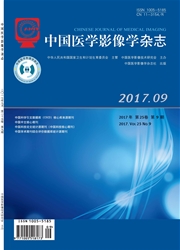

 中文摘要:
中文摘要:
目的 探讨迭代重建算法在肺动脉CT血管成像(CTPA)低剂量扫描中的临床应用研究。方法 将体质量指数为20~25的150例患者随机分成5组进行CTPA扫描,图像重建算法为ASIR(adaptive statistical iterative reconstruction),扫描范围为260~310 mm,第一组扫描条件为机器默认的120 k V、400 m As,对图像进行重建并计算信噪比(SNR)及对比度噪声比(CNR),请2位影像学家对图像进行5分值主观评价。固定120 k V,用350 m As、300 m As、250 m As及200 m As对其他组患者进行扫描,记录不同m As的CTDIvol及DLP,并转换为有效剂量ED。对上述扫描条件下图像进行重建,计算图像的SNR及CNR,并进行主观评价。结果 对120 k V,不同电流(400 m As,350 m As,300 m As,250 m As,200 m As)扫描产生的图像进行SNR及CNR评价,其值分别为:22.95、22.90、21.82、20.80、20.83和23.61、22.88、22.86、21.93、21.97。2位影像学家对120 k V下400~200 m As主观评价分值分别为:4.59±0.32,4.48±0.30,4.82±0.28,4.28±0.36,4.15±0.38;其CTDIvol、DLP平均值分别为:13.84 m Gy、11.18 m Gy、9.31 m Gy、8.25 m Gy、7.38 m Gy和351.21 m Gy、312.32 m Gy、286.26 m Gy、233.52 m Gy、206.08 m Gy,并将DLP转换为ED为5.27 m Sv、4.68 m Sv、4.29 m Sv、3.50 m Sv、3.09 m Sv。对上述数据进行单因素方差分析,200 m As、250 m As、300 m As、350 m As与400 m As产生的影像质量没有明显差异(F=5.285,P〉0.05),但200 m As的CTDIvol、DLP及ED较400 m As分别低46.7%、41.3%及41.3%。结论 体质量指数为20~25的被检者进行CTPA检查时最佳扫描条件为120 k V,200 m As。对于体型较小(肌肉较少)或有肺气肿等疾病可以选用180~200 m As进行扫描。
 英文摘要:
英文摘要:
Objective To investigate the effect of adaptive statistical iterative reconstruction and low radiation on the image quality of CT pulmonary angiography. Methods 150 patients whose body mass index was from 20 to 25 were divided into 5 groups underwent pulmonary angiography on a GE HD 750 CT scanners. The scanning range was from 260ram to 310mm, the first group of scan parameters were 120kV,400mAs, it was the acquiescent parameters of the CT scanner. Reconstruction was performed with ASIR, then the signal to noise ratio (SNR) and contrast to noise ratio(CNR) were calculated. The images of different strength of ASIR were read by 2 independent radiologists with 5-point-scale, then based 120kV, the other group patients were scaned with 350 mAs, 300 mAs, 250 mAs, 200 mAs, recorded the CTDIvol and DLP in different mAs. The effective dose (ED) was calculated based on the DLP, The SNR and CNR were calculated and the image quality were assessed by the two experienced readers. Results The images were assessed under different re_As (400 mAs, 350 mAs, 300 mAs, 250 mAs, 200 mAs) and the 120kV at the strength of 3, the values of the SNR and CNR were 22.95, 22.90, 21.82, 20.80, 20.83 and 23.61, 22.88, 22.86, 21.93, 21.97. The values of from 400 mAs to 200 mAs by two independent radiologists were 4.59±0.32, 4.48±0.30, 4.82±0.28, 4.28±0.36, 4.15±0.38. The CTDIvol and DLP of different mAs (400 mAs, 350 mAs, 300 mAs, 250 mAs, 200 mAs) were 13.84 mGy, 11.18 mGy, 9.31 mGy, 8.25 mGy, 7.38 mGy and 351.21 mGy, 312.32 mGy, 286.26 mGy, 233.52 mGy, 206.08 mGy. the ED were 5.27 mSv, 4.68 mSv, 4.29 mSv, 3.50 mSv, 3.09 mSv. Statistical analysis was performed using analysis of variance, and the date was not statistically significant(F=5.285, P 〉 0.05) at the exposure factors of 200 mAs, 250 mAs, 300mAs, 350mAs than 400 mAs, but the CTDIvol and DLP of 200mAs were reduced 46.7% and 41.3%, the ED was reduced 41.3%. respectively than the 400 mAs. Conclusion The best mAs is from 200 mAs for the average person whose BMI
 同期刊论文项目
同期刊论文项目
 同项目期刊论文
同项目期刊论文
 期刊信息
期刊信息
